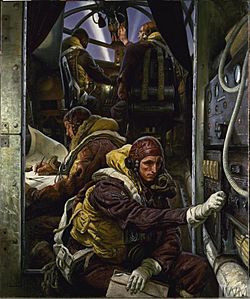Take Off (painting) facts for kids
Quick facts for kids Take Off |
|
|---|---|
 |
|
| Artist | Laura Knight |
| Year | 1943 |
| Medium | Oil on canvas |
| Dimensions | 182.8 cm × 152.4 cm (72.0 in × 60.0 in) |
| Location | The Imperial War Museum, London |
Take Off is a powerful painting by the English artist Laura Knight. She created it in 1943 during World War II. This painting shows a moment from the war and is now kept at the Imperial War Museum in London. Laura Knight was one of the official British war artists, meaning she was hired to create art about the war.
What the Painting Shows
This painting takes you right inside a British Short Stirling bomber plane. It was a big plane used by the Royal Air Force (RAF) during the war. You can see four of the seven crew members getting ready for their mission. They are about to take off for a night flight over Nazi Germany during World War II.
- Two pilots are in the cockpit, which is the front part where they control the plane.
- A navigator is busy looking at his maps, planning the route.
- In the front of the picture, a flight sergeant is turning a knob on a radio device. This was used for communication.
The painting makes you feel like you are right there with the crew. It shows how focused and serious they were before their dangerous flights.
How Laura Knight Made the Painting
Laura Knight spent a lot of time and effort to make this painting very accurate. She later said it was the hardest thing she had done during the war.
To understand what it was like, she worked at RAF Mildenhall. This was a real air force base. She even lived in the Women's Auxiliary Air Force (WAAF) Officers' Mess for several months. This helped her see how the aircrews lived and worked. She was even given an old Stirling bomber plane to study. This helped her paint all the details of the plane correctly.
The painting shows the moment the British crew prepares for take-off. They are all concentrating on their next mission. The painting is so detailed and realistic that it almost looks like a photograph.
Sadly, the navigator shown in the painting, Raymond Frankish Escreet, was later killed during the war. His mother received a copy of this painting to remember him.

